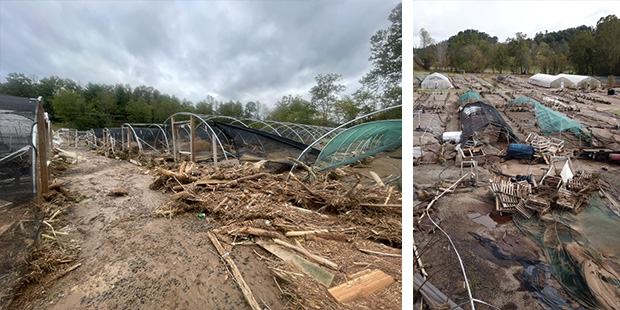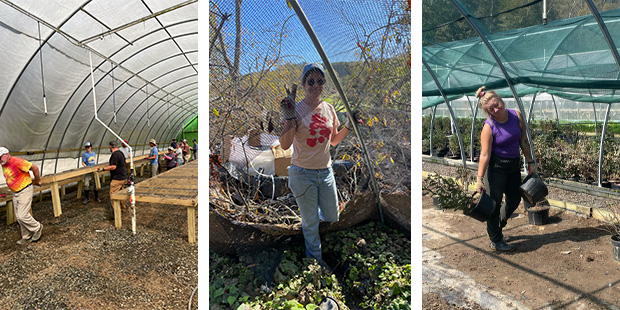When Hurricane Helene Devastated Carolina Native Nursery, the Community Rallied Together to Rebuild

It was a sunny Friday afternoon, September of 2024, when the storm had finally cleared in North Carolina.
Bill Jones drove from his home in Asheville to Carolina Native Nursery, his business in Burnsville, just 30 minutes away.
Although he expected storm damage, he did not expect to find thousands of black pots scattered across the valley or three feet of water still rushing through his shop.
“We’ve had hurricanes come through here before,” Jones said. “But nothing like this.”
Hurricane Helene dropped 30 inches of rain over western North Carolina in just three days. The trout stream that bordered the nursery swelled from 10 feet wide to 100 yards across and five feet deep.
Water tore through the operation — washing away 90% of Carolina Native’s plant inventory, destroying greenhouses, and leaving behind a tangled mess of debris.
Despite running through their hurricane checklist, which includes securing the property and ensuring there aren’t logs in the trout stream or feeder creek, nothing could have prepared the property for what was to come.
“The plants were gone, a lot of the gravel was gone, many of our greenhouses were either damaged or destroyed, and so it left us with just piles of stuff,” Jones said. “You can’t stop water like that. There’s just no physical way to do it.”
Jones tried to reach the nursery on three different roads that Friday. What he found was total devastation.
“We had to climb through downed trees,” he said.
Not only was their shrub yard and perennial farm destroyed, but the road above the nursery suffered a landslide, damaging the top of the property, and the bottom of the property had been washed away.
“All the phone lines were down, all the power was out. I tried to go find a woman who works here and is part-owner of the nursery — I couldn’t find her, I couldn’t get to her house,” he said.

Feeling helpless, that’s when Jones and his wife got back in their car and went home because at that point “there was absolutely nothing we could do,” he said.
Where to Go From Here?
Before the rebuild, filing an insurance claim was imperative. “Luckily, we have crop insurance,” Jones said. “Without the crop insurance we had, we never would have been able to afford to bring in all the stock to replant.”
By Thursday of the first week, volunteers began arriving. Landscape firms closed for the day and brought equipment.
“We had over 100 people out here helping us get all the trash out,” Jones said. “It was sort of helter-skelter at first, but we started our rebuild and we’ve been working on that ever since.”
Lost Inventory and The Community’s Response
Some plants survived — a few thousand up the hill were out of the flood’s reach. But others had gotten an inch or two of water in the base of the pot.
Even though those plants were salvageable, the Department of Agriculture deems them unsellable once they’ve sat in flood water.
For those plants, Jones and his team set up a donation program.
“We ended up donating well over 6,000 plants to nonprofits and volunteer groups trying to replant people’s stream banks and gardens,” Jones said. “That ended up being a beautiful thing.”
Jones doesn’t know how they could have gotten to where they are now without over 100 volunteers helping to pick up the property.
 The community support, he said, was humbling.
The community support, he said, was humbling.
“As an entrepreneur, you’re used to doing it yourself,” Jones said. “My wife was like, ‘You’ve got to accept these people’s help and let the volunteers come because all these people want to do it.’”
Jones partially attributes the outpouring of volunteers to the one-of-a-kind products Carolina Native offers.
“We are the native nursery that services this whole geographic area — the landscapers, the garden centers — and we’re sort of irreplaceable in the plant palette that we grow,” he said. “People needed us back up and running because they need what we have to do their work.”
The nursery launched a GoFundMe campaign that raised $150,000 and even received checks in the mail from strangers.
“In the long run, I think it’s made me a much more grateful and humble person,” he said of the support they received from all over the country.
A Three-Year Recovery
Jones estimates the nursery suffered about $2 million in damages. Crop insurance — a federally supported program he urges all growers to look into — covered roughly half of that value.
The nursery lost fourth-quarter sales last year and much of the spring season this year. But sales have now rebounded. Staffing has returned. Facilities are nearly rebuilt.
“With our perennials and our shrubs, we’ve recovered tremendously in sales,” Jones said. “With the azaleas, it’s going to be a while. But sales-wise, we’re in really good shape.”
Among the hardest losses to absorb were Carolina Native’s native azaleas — a specialty crop that Jones’ team grows from seed.
“We harvest the seed late in the fall, right after Thanksgiving,” Jones explained. “Then we grow the seedlings into liner trays the first year, into 1-gallons the second year, and 3-gallons the third.”
The nursery had tens of thousands of native azaleas on the ground across all stages — and lost nearly all of them.
“All the 1-gallons and 3-gallons were gone. A lot of our liner stock was gone,” Jones said.
With 13 species of native azaleas indigenous to the eastern U.S., Carolina Native is the largest grower of these plants in the country (they sell all 13). And because they can’t outsource this part of the business, rebuilding stock will take time.
“It’s going to be a two- to three-year process,” Jones said.
Meanwhile, the nursery’s perennials, ferns, grasses, and other native shrubs — sourced from outside growers — have bounced back quickly.
 “We already had those orders in the hopper,” he said. “So all that stuff we’re up and running on.”
“We already had those orders in the hopper,” he said. “So all that stuff we’re up and running on.”
Same Mission, New Perspective
Despite the upheaval, the nursery’s mission hasn’t changed.
“We grow beautiful, high-quality native plants for IGCs and landscapers,” Jones said.
He has no plans to change locations, either.
“In western North Carolina, the only flat land is near streams and rivers, and that’s where we are. We’re not moving,” he said. “We love western North Carolina. I sold my organic lawn and shrub care company in Charlotte to move up here to do this and raise our kids in the mountains.”
That commitment to place — and to the people they serve — has paid off.
“Whether [our clients] are wholesale or retail, garden centers or landscapers, they’ve come roaring back,” he said. “They were just waiting for us. They didn’t turn and start buying from other nurseries.”
Advice to Other Growers
Having gone through Hurricane Helene, what advice does Bill have for other growers, particularly those in vulnerable regions?
“If you haven’t examined crop insurance and put that as an expense line, it will save your business,” Jones said. “It’s a federal program that is available to everyone who grows a crop.”
“And secondly, if you are met with disaster and people want to volunteer to help, let them. You can do it all yourself. But why? It makes you feel good. It makes them feel good.”
Today, Carolina Native is almost totally renovated. There are just a couple of greenhouses at the corner of the nursery to rebuild that Jones likens to “having one room left to paint before being done with the house.”
But ultimately, he’s incredibly proud to have gotten back to mostly normal operations after such a devastating blow from Hurricane Helene.
“We’re just so happy to be selling plants again,” Jones said. “And that’s what everybody’s working on, either growing or selling. We’re just so grateful to everybody that’s helped us.“
Tags: Hurricane Helene